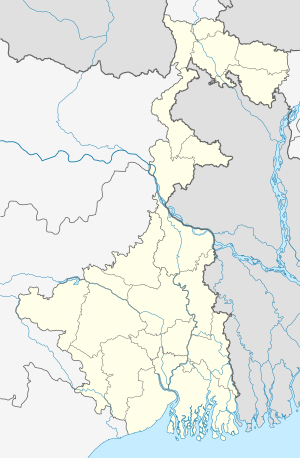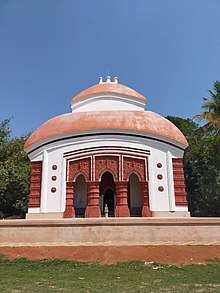Samta, India
Samta (pronounced [ʃaːmtaː]) is a village and a gram panchayat in the Howrah district of West Bengal, India, on the banks of the Rupnarayan river. Samta is noted for being the home of Sarat Chandra Chattopadhyay (namely, Sarat Chandra Kuthi) for twelve years, starting from the year 1923. The terracotta temple of Madangopal jiu is located in the neighbouring village of Mellak. Samta is connected to the state capital, Kolkata, through the National Highway 6, that also connects it to the nearby towns of Bagnan and Kolaghat. Samta hosts few educational facilities including the Samta Sarat Chandra Girls High School, among others.
Samta | |
|---|---|
Village | |
 Samta Location in West Bengal, India  Samta Samta (India) | |
| Coordinates: 22.4720338°N 87.90793059999999°E | |
| Country | |
| State | West Bengal |
| District | Howrah |
| Languages | |
| • Mostly Spoken | Bengali |
| Time zone | UTC+5:30 (IST) |
| PIN | 711324 |
| Telephone code | 03214 |
| Lok Sabha constituency | Uluberia |
History

During the British Raj, Samta was the power-hold of the local Roy zamindars, subordinate to the Burdwan Raj Estate, who was in turn subordinate to the British empire. Following Indian independence, the village came to be governed by the government of India.
Festivals including Dol purnima, Durga puja, Shivaratri, Shitala puja, Itu puja, and Janmashtami, among others, are celebrated in the village. Gajan sessions are also held during festivals. The terracotta temple of Madangopal jiu, built in the 17th-century CE, is located in the neighbouring village of Mellak, south of Samta.[1] It is locally known as Gopaler Mondir (literally, "the temple of Gopala"). The temple was commissioned by Mukundaprasad Roychowdhury, a member of Mellak's then Roychowdhury zamindars.
Samta was home to Bengali novelist, Sarat Chandra Chattopadhyay, for twelve years, until he moved to Kolkata. His house in Samta, constructed in 1923 by local worker Gopal Das, is known as Sarat Chandra Kuthi (or alternatively as, Sarat Smriti Mandir).[2][3] He had fenced his house and the adjacent area, renaming it as Samtaber.[2] His novels such as Devdas were serialised during his stay in Samta,[2] while he wrote stories including Ramesh and Ramer Sumati, among others, during the years he lived in the village.[4] Sarat Chandra Kuthi is a heritage-historical site under the West Bengal Heritage Commission Act (IX) of 2001.[4][5] In 2009, the structure underwent renovation.[4] An annual fair, by the name of Sarat Mela, is held in late January in Samta's neighbouring village Panitras, located north of Samta, in remembrance of the novelist.
Geography
Samta is located on the plains of the Rupnarayan river, situated about a kilometre (0.62 miles) away from its banks.[4]
Infrastructure
Education
There are a few schools in Samta including Samta Sarat Chandra Girls High School (established by Sarat Chandra Chattopadhyay himself, in 1924)[2] and Samta Primary School.
Transport
The village is connected to the National Highway 6, also known as the Bombay Road, through a road known as the Sarat Road.[1] The national highway links Samta to Kolkata, the state capital, and towns including Bagnan and Kolaghat.[1][6] The village has a barrage, a kind of breakwater, created to protect the village in times of floods. The barrage road, the Sarat Road, and other village roads together links Samta to its nearby villages including Mellak, Panitras, Birampur, and others. The Sarat Road starts at Mellak from the national highway, south of Samta, and extends to Kalyanpur and Hooghly in the north.
Local transport exists in the form of rickshaws, rickshaw-vans, and trekkers (a kind of jeep). The nearest railway station is the Deulti railway station located across the highway, that connects Samta and its neighbouring villages to the Howrah Junction railway station.[4]
Gallery
- Ixora flowers in a house's garden
- Sculpture of a Hindu deity, in Samta
- Mud houses in the village
- Arches of the Madangopal temple
- Terracotta motif on the walls of the Madangopal temple
- Old wing of the Samta Sarat Chandra Girls High School
References
- "ঘুরে আসুন রূপনারায়ণের ধারের দেউলটি" [Visit Deulti on the banks of Runarayan]. Ebela. 26 September 2016. Archived from the original on 5 September 2019. Retrieved 10 September 2019.
- Sil, Narasingha Prosad (2012). "6". The Life of Sharatchandra Chattopadhyay: Drifter and Dreamer. Lexington Books. pp. 54–55.
- Basu, Anjana (11 December 2015). "For the love of picnics". The Hindu Business Online. Archived from the original on 5 September 2019. Retrieved 10 September 2019.
- Sumi, Afsana (28 November 2017). "শরৎপ্রেমীরা ঘুরে আসুন শরৎচন্দ্র কুঠি থেকে" [Lovers of Sarat come visit Sarat Chandra Kuthi]. Priyo. Archived from the original on 5 September 2019. Retrieved 10 September 2019.
- "West Bengal Heritage Commission Act 2001 (Act IX of 2001)" (PDF). Archived (PDF) from the original on 22 July 2012. Retrieved 20 March 2012.
- "Plants". The West Bengal Power Development Corpn. Ltd. Archived from the original on 21 February 2009. Retrieved 19 March 2012.
See also
External links
| Wikimedia Commons has media related to Samta, India. |